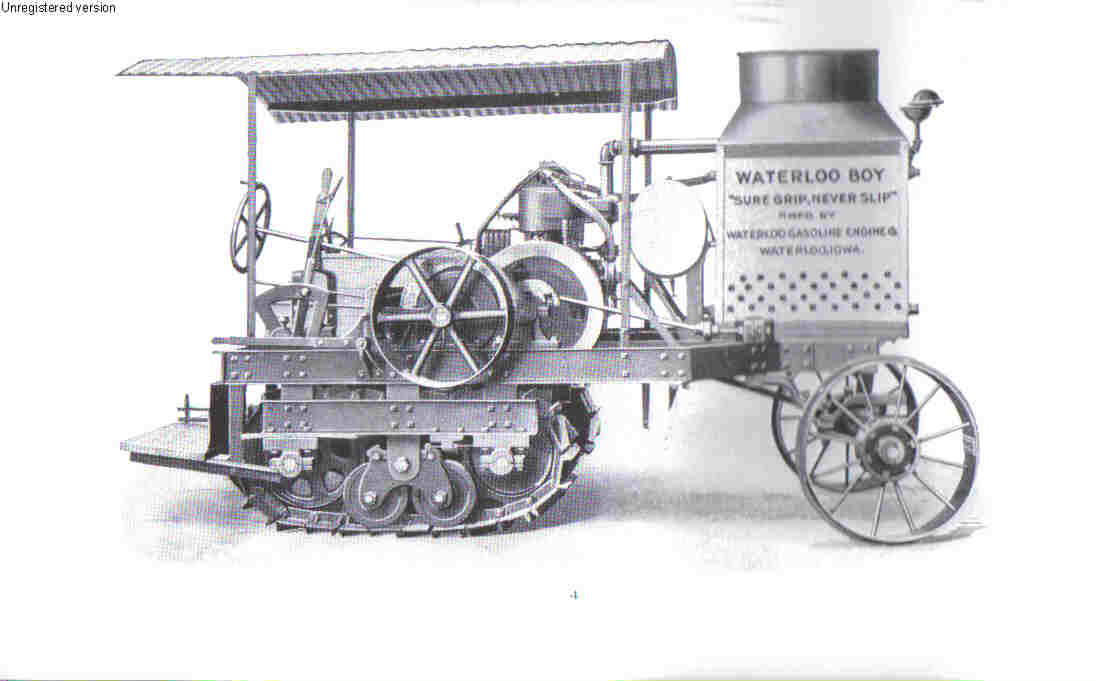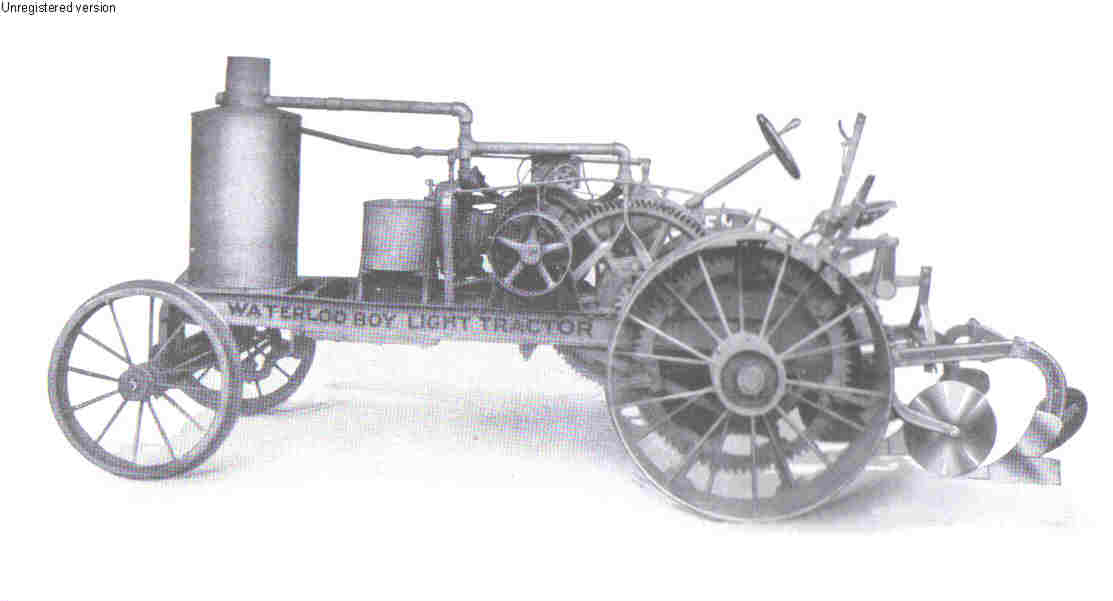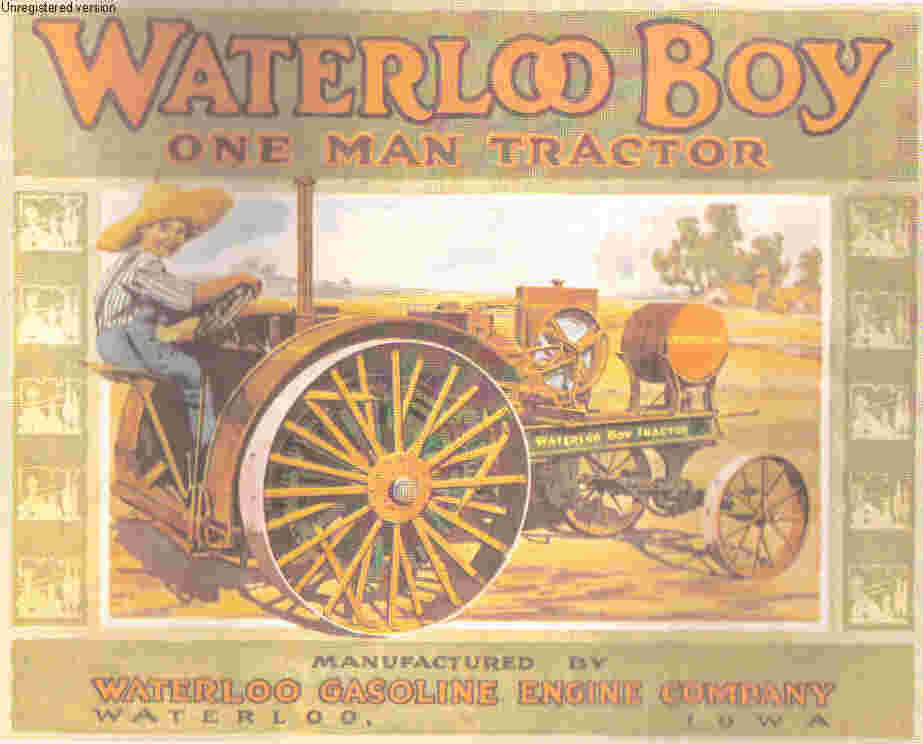A History of the
Waterloo Gasoline
Engine Company
|
|
In 1911 the first Waterloo Boy tractors were introduced, the
Model L and LA. The Waterloo Gasoline Engine Company had
built a successful business manufacturing stationary
engines. They were still struggling to produce an acceptable
traction engine after the prior 18 years of experiments and
failures.
A. B. Parkhurst was invited by the company to give a demonstration
of his own designed tractor in 1911. Following that, 3 units were
ordered and one was sold. These tractors had a two cylinder,
two cycle engine, but field performance was not acceptable and
no more units were ordered.
Mr. Parkhurst, now an employee of the company was instructed to
design a 4 cylinder engine to power his tractor, however field
performance was still not acceptable and late in 1912 Mr.
Parkhurst left the company.
Mr. Parkhurst's tractor did leave one lasting impression on the
Waterloo Gasoline Engine Company.....the horizontal two cylinder engine.
Waterloo Boy Standard Tractor 1912

Lou Witry, chief engineer of the company believed he could
build a better tractor and so set to work to produce the first
successful Waterloo Boy tractors. Work then started on the
design of a Waterloo Boy tractor with an opposed two cylinder
engine, a machine that would eventually see production.
In 1913 a Harry Leavitt started work on re-designing the
Parkhurst tractor into a crawler design, called the Sure Grip,
Never Slip. Few of these tractors were ever sold as manufacture
was difficult and there was a limited market for them.
Waterloo Boy Sure Grip, Never Slip Tractor

Beginning in 1914 production of the Model L (Light) Waterloo Boy
tractor began. The Model L and a larger model H had been produced
before this, but company records do not leave much valuable
information about them.
The Model L had a production run of two tractors, serial number 1000
and number 1001 before a revised Model LA was produced. The LA
came in both 3 and 4 wheel versions with a 15 horsepower engine.
One speed forward and one reverse.
The horizontally opposed engine had a 5.5 bore and 7 inch stroke,
operating at750 rpm. It was rated at 15 horsepower and weighed
3,000 pounds.
Waterloo Boy Model L (Light) Tractor

Sometime during this period there was also work being done on a
Model C. There are no production records for it, but it was a four
wheel drive tractor. The Model C had a 15 horsepower opposed
engine, weighed 3235 pounds and was advertised as being a 3
bottom plow tractor.
Still the opposed two cylinder engine remained unsatisfactory and
work began on a horizontal, side by side engine. By June of 1914
the new engine was ready for mounting on the existing Model LA chassis.
There were many design changes to the chassis along with the addition
of an automotive type worm and sector steering system....a big
improvement over the previous chain and capstan.
The new Waterloo Boy tractor also received a new model designation,
the Model R, with the first tractor being produced serial number 1026.
The Waterloo Boy Model R burned kerosene, a cheap fuel farmers
could afford and due to the improved design of the engine, it was
easier to keep enough heat on the intake manifold to properly
vaporize the fuel.
The R was sold as a 2 plow tractor, although in better conditions could
pull 3 14 inch bottoms. The selling price was initially $750.00.
The Model R was successful and by 1916 became a steady seller thus
establishing the Waterloo Gasoline Engine Company in the tractor
business. But perhaps more importantly, the Model R Waterloo Boy
became the first of a long line of highly successful two cylinder
tractors.
1916 Waterloo Boy Model R advertisement

Tidbits & trivia about tractors
The origin of the word "tractor" is credited to the year 1906 and
the establishment of the name to Charles W. Hart and Charles H. Parr
of Charles City, Iowa. These two gentlemen are also credited with
building the first successful internal combustion engine tractor and
founding the gasoline tractor industry.
There is also a story that a W. H. Williams, Sales Manager of
the Hart Parr Company was writing and advertisement for the
machine and decided that gasoline traction engine was too
cumbersome when visions of a new word, tractor, came into his head.
However, the word tractor had been placed on a patent filed in
1890 on a tractor invented by George H. Edwards of Chicago.
It was patent No. 425,600.
The Hart Parr tractor was the forerunner of the Oliver Tractor introduced
in 1930.
Back to the
Froehlich Tractor Story
Next: the
Waterloo Boy Tractors
Return to:
a History of Deere Tractors
|